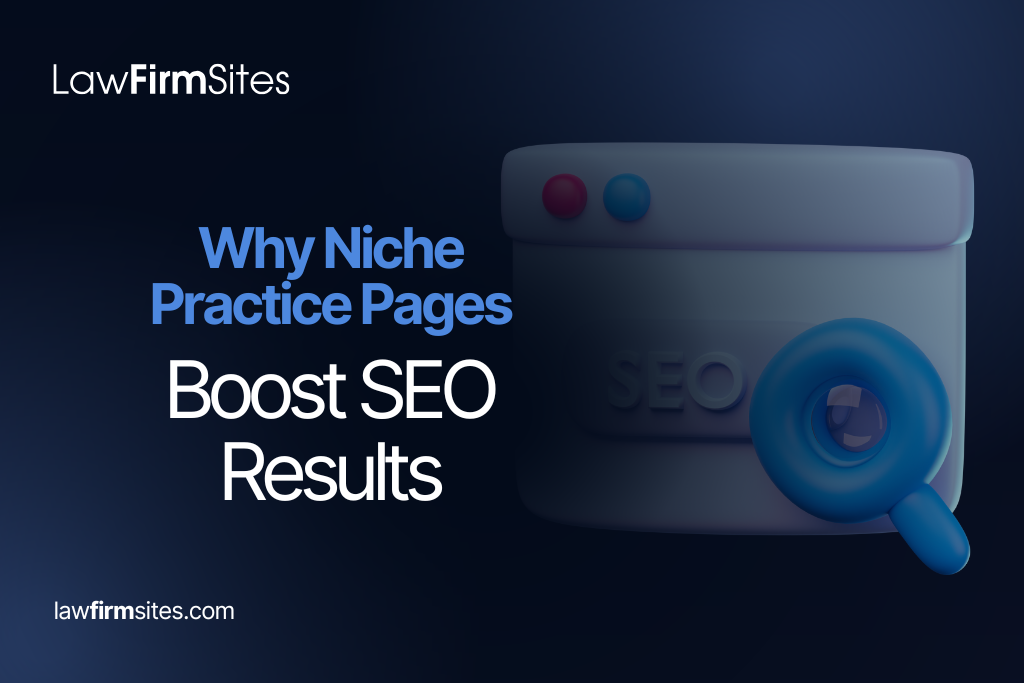Why Niche Practice Pages Boost SEO Results?

Niche practice pages are the quiet workhorses of modern legal SEO, turning broad interest into qualified intent and qualified intent into signed engagements. By aligning specific questions with focused answers, these pages show search engines that your site serves people first and solves concrete problems. They also make it easier for potential clients to find the exact service that matches their situation. For law firms seeking sustainable growth, niche practice pages are no longer optional – they are essential.
Benefits of Targeted Niche Keyword Usage in Law Firm SEO
When a website organizes its content around highly specific legal scenarios, it creates a direct path between the searcher’s language and the page’s solution. A general “family law” page competes with thousands of similar pages, but a focused resource such as “Post‑Decree Child Support Modification for Self‑Employed Parents in New Jersey” meets a clearly defined query with precision. That precision reduces ambiguity for both readers and algorithms, which improves relevance signals and increases the chance that the page will surface for searches with strong intent.
In conjunction, higher relevance also supports stronger ranking potential. Search algorithms are designed to surface content that demonstrates clear topical alignment, depth, and usefulness. Niche practice pages naturally encourage all three because they address narrower facts, procedures, timelines, and remedies. As those pages earn impressions and clicks from people who feel “this is exactly what I need,” engagement metrics tend to improve, which can reinforce visibility over time.
The most practical win from niche keywords is audience fit. People rarely search for an attorney in vague terms when they are ready to act. They search in the language of their problem: “accounting disputes in trustee removal,” “emergency custody order San Diego weekend judge,” or “E‑2 investor spouse work authorization steps.” When your site mirrors those phrases with clear, helpful explanations, you meet them at the moment of decision. Because these visitors are already aligned with the service, they progress from visit to inquiry at a much higher rate than traffic earned from broad head terms.
Conversion gains are where niche pages shine – for instance, someone who lands on a page about “California financial elder abuse litigation for bank transfers over $10,000” is not window‑shopping; they are seeking immediate guidance on a specific remedy. By offering step‑by‑step explanations, eligibility checkpoints, jurisdictional nuances, and likely next actions, that page reduces friction and builds trust. This combination of high relevance and clarity increases the likelihood that a reader will request a consultation.
The Importance of Niche Content Creation in Law Firm Websites
Building niche practice pages is more than a keyword exercise. It is a content strategy that prioritizes people’s real questions and the context around those questions. Strong pages begin with searcher intent and expand into a complete resource. They define who the page is for, what legal standards apply, which documents or evidence matter, how courts view the issue, what timelines typically look like, and what outcomes may be realistic. They avoid generic platitudes and instead provide concrete, jurisdiction‑specific details that help readers take the next step with confidence.
Content structure and depth
Depth matters, but so does structure. Each niche page should resolve a single, well‑scoped topic and make that scope obvious in the title, H1, and introductory paragraph. Use plain language so that a layperson can understand the process without legal jargon. Include related subtopics that answer follow‑up questions a reader will likely ask five seconds later. For example, a page on “Trustee Removal for Failure to Account in Arizona” might cover statutory grounds, evidence of breach, court procedure, interim remedies, settlement levers, and common defenses. Linking to authoritative statutes, court resources, and supporting guides helps readers and assists search engines in understanding page credibility and context.
Content freshness
Freshness is another essential element as law and procedures evolve, court backlogs change, filing fees shift, and new case law reframes standards. A niche page that is not updated risks losing visibility and, more importantly, reader trust. Build a review cadence for every practice‑critical page. Add new examples, refine explanations based on recent rulings, and update timelines or thresholds when rules or forms change. Small updates signal ongoing relevance, while major revisions can reflect new legislation or a procedural overhaul.
Content clarity
Technical clarity supports the content. Descriptive title links that match the page’s intent, succinct meta descriptions that set accurate expectations, and clean URLs that echo the topic help both readers and search engines. Structured data can make content easier to parse by machines and, where eligible, can enable richer display features. Internal links should guide users from broad practice hubs to niche topics and back again, spreading authority and helping visitors find exactly what they need without dead ends.
Important Factors to Keep in Mind When Creating Niche Content
The relationship between niche quality and trust is direct. Search engines increasingly reward content that demonstrates experience, clear sourcing, and usefulness. This is not a race to publish the most pages, but a commitment to craft pages that genuinely help someone solve a legal problem or understand their next step. When your content consistently reflects lived experience, accurate citations to official resources, and a balanced tone, the site earns credibility signals that compound over time.
SEO Rankings
Niche practice pages can lift rankings because they reduce competition and sharpen topical authority. Instead of forcing a single page to do everything for “probate,” separate pages can address “probate for blended families in Harris County,” “summary administration thresholds in Florida,” or “small estate affidavits in Illinois.” Each page is a specific doorway for the exact query it serves, making it more likely to rank for the terms people actually type.
Topic clusters enhance this effect. A hub‑and‑spoke model, where a comprehensive hub page introduces the area and links to multiple deep‑dive spokes, sends clear signals about coverage. As the spokes earn links and engagement, the hub benefits, and vice versa. Over months, as you publish and refine multiple spokes around the same legal theme, the site’s perceived expertise on that theme strengthens, leading to broader visibility for semantically related searches.
Targets Specific Audiences
Specificity speaks directly to the person behind the query. Someone searching “emergency guardianship for elderly parent in Phoenix” expects to see requirements, forms, the relevant court, average timelines, and what to do if a bank refuses access during the petition period. A narrowly focused page can deliver all of this in a single visit. That direct fit reduces pogo‑sticking, lengthens time on page, and encourages readers to explore adjacent resources. It also reduces the energy a visitor must expend to understand whether your firm can actually address their situation.
Audience targeting through niche content also respects the decision cycle. People at the awareness stage use broad queries; those closer to action use detailed, long‑form questions. By mapping content to later‑stage terms, you align pages with users who are closer to hiring. This approach does not ignore broader keywords, but it treats them as hubs that direct to more actionable resources. Over time, analytics will show that the highest value queries are often the most specific ones.
Higher conversion rates
Niche practice pages convert because they remove uncertainty. They often include eligibility thresholds, red flags that require swift action, documentation checklists, and practical process maps. They avoid vague promises and focus instead on what the law allows, what the court expects, and how outcomes vary based on facts. When a reader finishes such a page, they should know whether they are in the right place, what information to gather next, and what an initial consultation will likely cover.
To support conversion ethically, the page should make the next steps easy without pressure. Prominent but respectful calls to schedule time, links to intake forms, and clear disclosures about scope and jurisdiction show professionalism. Case studies or anonymized scenarios can illustrate how similar disputes or applications were resolved. Accessibility matters too; readable typography, scannable headings, and mobile‑first layout keep the focus on clarity rather than design flourishes.
The Importance of Optimizing and Updating Niche Content
Optimization begins with aligning the page to a distinct search intent and ensuring every on‑page element reinforces that intent. The title and H1 should use the same core phrase with natural variations. The opening paragraph should define the problem in plain words and preview the solution. Subheadings should break down the process into digestible sections that mirror a user’s mental checklist. Alt text should describe images meaningfully, especially if the images are procedural diagrams or court form screenshots. Internal links should lead to statutes, court portals, related practice pages, and reputable third‑party resources such as government agencies.
- Measurement is an important part of optimization, and it is crucial to track the queries that actually drive impressions and clicks to each niche page. If you see unexpected long‑form queries surfacing, add a section that directly addresses them. If searchers are arriving with local modifiers like cities or courthouse names, incorporate a location paragraph that explains the venue and local rules. Over time, these incremental refinements accumulate into a page that is both comprehensive and easy to use.
- Updating content should be an ongoing practice, and not an annual chore. Your team must set a schedule to review high‑value pages quarterly, with ad hoc updates whenever rules change or new evidence emerges. When you revise, do more than change a date. Add new examples, clarify confusing steps, expand FAQs that reflect actual user behavior in your analytics, and remove outdated references. If a page grows too long, split it into subpages and connect them with obvious links so readers can go deeper without getting lost.
- Trust cues deserve attention during updates. Cite official sources when discussing statutes, timelines, or procedural requirements. Link to government portals for forms and fee schedules. Where appropriate, add author bios that explain relevant experience in the topic. These details help readers feel secure that they are receiving reliable guidance rather than generic summaries.
How Dominating Local SEO Influences Overall Rankings?
Local visibility and organic rankings reinforce each other. When your Google Business Profile is accurate, frequently updated, and supported by a site structure that mirrors your services and locations, you create a cohesive presence across the web. Clear practice area pages for each city or county you serve, paired with consistent NAP data and a steady cadence of high‑quality reviews, help search engines connect the dots between your site, your profile, and real‑world activity. That consistency improves the likelihood of appearing in local packs for service‑plus‑location searches.
Proximity, relevance, and prominence are the levers in local search. You cannot move your office closer to the searcher, but you can strengthen the two levers you control. Relevance grows when your niche pages exactly match the phrasing and intent of local queries, such as “trustee removal for accounting disputes in Roseland” or “probate for estates under threshold in Cook County.” Prominence grows when your content earns mentions, your profile accumulates recent, high‑quality reviews, and your site is referenced by trusted local and legal directories. Over time, these signals increase map visibility and send additional branded traffic to your site.
Local dominance compounds because it drives user behavior that algorithms read as trust. When searchers see your firm repeatedly in map results and organic results for the same specific term, they are more likely to click, call, or request directions. Those actions feed back into visibility, while your niche pages close the loop by satisfying the exact question that brought the visitor to you in the first place. Even outside your immediate city, strong niche resources can attract visibility in surrounding areas, especially for queries where depth and clarity outweigh distance.
There is also a reputation effect. Reviews that mention specific services or outcomes, location‑specific landing pages with clear schema markup, and citations in respected local publications build a coherent signal that your firm actually serves the needs described on your site. This unity between what you claim and what the market reflects is a durable advantage that supports both local and traditional organic rankings.
Jumpstart your SEO growth using the best guides
Niche practice pages lift legal SEO because they match real‑world problems with focused, trustworthy answers. They help your site earn visibility on precise queries, attract searchers with strong intent, and convert those visits into meaningful engagements. When paired with a disciplined update schedule and a robust local presence, these pages create momentum that broad general pages rarely achieve on their own.
If you want strategic help mapping and building these assets, Law Firm Sites can set you up with a practical conversation about which pages should be prioritized.
Did you like this post? Here are some others you might enjoy:

For most law firms, growth depends on being visible at the exact moment a potential client searches for help. Pay‑per‑click…

Strong legal marketing rewards depth. When potential clients face high-stakes decisions, they search for thorough, trustworthy guidance that clearly explains…

Data is the most reliable guide for growing a law firm website because it shows what clients actually search, where…

